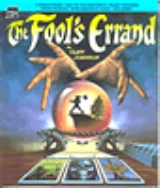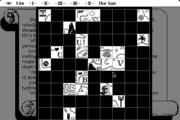
The Fool's Errand
Encyclopedia
The Fool's Errand is a 1987 computer game by Cliff Johnson
. It is a meta-puzzle
game with storytelling, visual puzzles and a cryptic treasure map
. It is the tale of a wandering Fool who seeks his fortune in the Land of Tarot
and braves the enchantments of the High Priestess.
According to Johnson, a sequel, titled The Fool and His Money
, is now scheduled for release in January 2012.
, Commodore Amiga
and Atari ST
. The ports add color, but in a lower resolution
(320x200, as opposed to the original version's 512x342). Johnson's site advises PC-based players to download the Macintosh version and play using an emulator
, specifically mentioning Executor
, but other open source emulators will work as well.
The non-Macintosh versions of the game were protected by a symbol-based code wheel
. The version offered free of charge given by the author has this mechanism disabled: the challenge screen still appears, but any answer is accepted.
had high praise for the game, saying "You feel like you're matching wits with the author directly, instead of playing "hunt the parser.""
The Fool's Errand won the following awards:
or a name given to a card in the Minor Arcana
.
Frequently, the puzzles are designed in such a way that the result of the puzzle leads logically into the unlocked chapter; for example, the player may complete an acrostic puzzle which results in the phrase "No Ship", which then unlocks part of the story in which a watchperson indeed reports that no ship has been sighted and deals with the consequences. Other puzzles feature pictures which portray parts of the story, or even clues to other puzzles.
 The very first chapter, The Sun, features the puzzle The Sun's Map. This is a jigsaw puzzle with one piece for every chapter in the story; each puzzle piece appears only when the appropriate chapter is unlocked. Each piece contains a symbol representing the chapter from which it came, plus part of a continuous path which flows through all pieces in the order in which they are mentioned in the narrative. Once the map is successfully completed, other designs on the map become active click targets and can be used as clues or processes to decipher the true final puzzle: The Book Of Thoth, hidden within the chapter The High Priestess, which requires the reader to peruse the entire story as continuous prose and identify a number of phrases hidden within the narrative.
The very first chapter, The Sun, features the puzzle The Sun's Map. This is a jigsaw puzzle with one piece for every chapter in the story; each puzzle piece appears only when the appropriate chapter is unlocked. Each piece contains a symbol representing the chapter from which it came, plus part of a continuous path which flows through all pieces in the order in which they are mentioned in the narrative. Once the map is successfully completed, other designs on the map become active click targets and can be used as clues or processes to decipher the true final puzzle: The Book Of Thoth, hidden within the chapter The High Priestess, which requires the reader to peruse the entire story as continuous prose and identify a number of phrases hidden within the narrative.
Cliff Johnson (game designer)
Cliff Johnson is an American game designer, best known for the early computer puzzle games The Fool's Errand and 3 in Three . Both games were notable for unique visual puzzles and a metapuzzle structure.- Biography :...
. It is a meta-puzzle
Meta-puzzle
A metapuzzle is a puzzle that unites several puzzles that feed into it. For example, five puzzles that had the answers BLACK, HAMMER, FROST, KNIFE, and UNION would lead to the metapuzzle answer JACK, which combines with all of those words to make new words and phrases.A "meta-meta" unites several...
game with storytelling, visual puzzles and a cryptic treasure map
Treasure map
A treasure map is a map that marks the location of buried treasure, a lost mine, a valuable secret or a hidden locale. More common in fiction than in reality, "pirate treasure maps" are often depicted in works of fiction as hand drawn and containing arcane clues for the characters to follow...
. It is the tale of a wandering Fool who seeks his fortune in the Land of Tarot
Tarot
The tarot |trionfi]] and later as tarocchi, tarock, and others) is a pack of cards , used from the mid-15th century in various parts of Europe to play a group of card games such as Italian tarocchini and French tarot...
and braves the enchantments of the High Priestess.
According to Johnson, a sequel, titled The Fool and His Money
The Fool and His Money
The Fool and His Money is a forthcoming puzzle game by Cliff Johnson. It is a self-published sequel to the 1987 game The Fool's Errand...
, is now scheduled for release in January 2012.
Release information
The game was originally written for the Apple Macintosh and ported to MS-DOSMS-DOS
MS-DOS is an operating system for x86-based personal computers. It was the most commonly used member of the DOS family of operating systems, and was the main operating system for IBM PC compatible personal computers during the 1980s to the mid 1990s, until it was gradually superseded by operating...
, Commodore Amiga
Amiga
The Amiga is a family of personal computers that was sold by Commodore in the 1980s and 1990s. The first model was launched in 1985 as a high-end home computer and became popular for its graphical, audio and multi-tasking abilities...
and Atari ST
Atari ST
The Atari ST is a home/personal computer that was released by Atari Corporation in 1985 and commercially available from that summer into the early 1990s. The "ST" officially stands for "Sixteen/Thirty-two", which referred to the Motorola 68000's 16-bit external bus and 32-bit internals...
. The ports add color, but in a lower resolution
Display resolution
The display resolution of a digital television or display device is the number of distinct pixels in each dimension that can be displayed. It can be an ambiguous term especially as the displayed resolution is controlled by all different factors in cathode ray tube , flat panel or projection...
(320x200, as opposed to the original version's 512x342). Johnson's site advises PC-based players to download the Macintosh version and play using an emulator
Emulator
In computing, an emulator is hardware or software or both that duplicates the functions of a first computer system in a different second computer system, so that the behavior of the second system closely resembles the behavior of the first system...
, specifically mentioning Executor
Executor (software)
Executor is software for x86-based PCs that allows older 68k-based Apple Macintosh programs to be run under various x86-based operating systems. Executor was created by ARDI...
, but other open source emulators will work as well.
The non-Macintosh versions of the game were protected by a symbol-based code wheel
Code wheel
A code wheel is a type of copy protection used on older computer games, often those published in the late 1980s and early 1990s. It evolved from the original "manual protection" system in which the program would require the user to enter a specific word from the manual before the game would start...
. The version offered free of charge given by the author has this mechanism disabled: the challenge screen still appears, but any answer is accepted.
Reception
Computer Gaming WorldComputer Gaming World
Computer Gaming World was a computer game magazine founded in 1981 by Russell Sipe as a bimonthly publication. Early issues were typically 40-50 pages in length, written in a newsletter style, including submissions by game designers such as Joel Billings , Dan Bunten , and Chris Crawford...
had high praise for the game, saying "You feel like you're matching wits with the author directly, instead of playing "hunt the parser.""
The Fool's Errand won the following awards:
- 1988 MacWorldMacworldMacworld is a web site and monthly computer magazine dedicated to Apple Macintosh products. It is published by Mac Publishing, which is headquartered in San Francisco, California...
Game Hall of Fame - 1989 GAMES MagazineGAMES MagazineGames magazine is a United States magazine devoted to games and puzzles, and is published by Games Publications, a division of Kappa Publishing Group.-History:...
Best Puzzle Game of the Year
Structure
The game is structured as a storybook divided into five parts, each containing a large number of different chapters; the storybook can be paged through and read as continuous prose on screen. However, not every chapter is available at the start of the game, and those chapters which are available are not consecutive. Many chapters have a puzzle (called an enchantment) associated with them; completing such a puzzle unlocks further chapter(s). Every chapter is either named after a tarot card in the Major ArcanaMajor Arcana
The Major Arcana or trumps are a suit of twenty-two cards in the tarot deck. They serve as a permanent trump suit in games played with the tarot deck, and are distinguished from the four standard suits collectively known as the Minor Arcana...
or a name given to a card in the Minor Arcana
Minor Arcana
|thumb|[[King of Swords]] card from a Minor Arcana deckThe Minor Arcana of occult or divinatory tarot refers to the portion of a Tarot deck that consists of 56 cards. The Minor Arcana are roughly similar to the cards found in a common deck of playing cards...
.
Frequently, the puzzles are designed in such a way that the result of the puzzle leads logically into the unlocked chapter; for example, the player may complete an acrostic puzzle which results in the phrase "No Ship", which then unlocks part of the story in which a watchperson indeed reports that no ship has been sighted and deals with the consequences. Other puzzles feature pictures which portray parts of the story, or even clues to other puzzles.

External links
- Official Site, with author's information page, including download options
- Hints and Answers from Balmoral Software.

